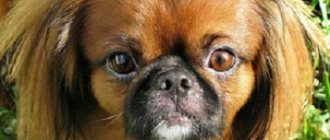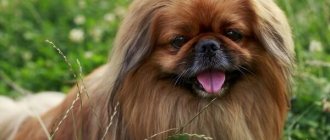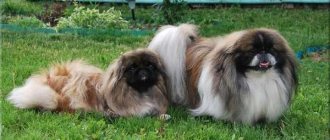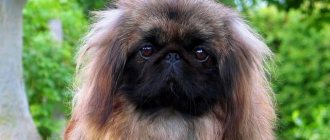Each breed of dog has a predisposition to certain diseases. We have collected information about typical diseases of the breed. Remember the symptoms of the disease, which every pet is at risk of developing, and then you can help him in a timely manner.
Pekingese were bred in China for the imperial family. Today they are excellent companion dogs who greet everyone they meet with dignity and grace.
- Country of Origin : China
- Height at withers : 15-25 cm
- Weight : male 3.2-5.0 kg, female 3.6-5.4 kg
- Lifespan : 12-15 years
- Use : companion dog
- Other names : Pekingese spaniel, Pekingese palace dog, pocket dog
Origin of the breed
Pekingese are one of the oldest breeds. Their homeland is Ancient China, where they were kept at the imperial court and were inaccessible to ordinary people. No one except the monarch could own a dog, and whoever stole it was subject to the death penalty. It was believed that the Pekingese protected the royal person in the afterlife, which is why the emperor was buried with his favorite.
An ancient Chinese legend says that the king of beasts fell in love with a monkey and married it. Their cubs inherited the proud and courageous character of their father and the funny appearance of their mother. This may be why Pekingese are called little lions.
The name comes from the English word "Pekingese", which means "Beijing", but the Chinese continue to call the shaggy dogs Fu.
Pekingese were brought to Europe in 1860, when the British captured China. Several purebred individuals, brought as trophies, were presented as gifts to Queen Victoria and her entourage.
In 1898, Pekingese were brought to America. The first exhibition in which representatives of this breed took part took place there. Since that time, small long-haired charmers have become extremely popular. But by that time there were practically no Pekingese left in China; later they began to be brought to their historical homeland from European countries.
The first breed standard was adopted in 1898, and in 1904 the first Pekingese fan club was adopted.
Breed standard
The Pekingese's calling card is its original exterior combined with a regal gait. These are small, proportionally built dogs weighing from 2.5 to 5.5 kilograms. Height at the withers does not exceed 25 centimeters. Appearance description:
- The head is large and wide. The skull is moderately flat. The eyelids, lips, and nose are pigmented, black, forming a mask. A V-shaped fold stretches from the cheekbones to the nasal fold.
- The muzzle is short. The jaws are strong.
- The eyes are round, large, shiny. The color must be dark.
- The nose is large, not too short, with a flat nose. The nostrils are open. The profile is snub-nosed.
- The ears are heart-shaped and droop downwards. Densely covered with fur.
- The neck is thick, short, powerful.
- The chest is wide, the ribs are convex.
- The back is straight.
- The limbs are shortened and strong.
- The tail is set high, fluffy, lying on the back.
The Pekingese is proud of its luxurious coat with abundant dense undercoat. It forms a thick mane in the neck and shoulder area, which makes the dogs look like lions. The fur on the hind legs is also elongated.
As for colors, red is considered traditional. The standard allows white, gray, spotted, sand, and black coat colors.
Diseases of the spine and limbs
Due to the large length of the body and short legs, the Pekingese spine is also subject to overload. Conditions such as:
- osteochondrosis - the dog whines because it is bothered by pain . Touching the back area is sharply painful;
- the appearance of a hernia - most often the cause is a jump from a height. Spinal pain is accompanied by a lag in movements in the paw on the affected side. It is difficult for the Pekingese to change body position: stand up or lie down;
- arthritis - may be the result of hypothermia. The dog does not use the affected limb when walking and drags it. The inflamed joint increases in volume.
If you experience such symptoms, you should also consult your doctor. In the case of a hernia or arthritis, surgery may be necessary.
Health, typical diseases
Pekingese can be called record holders for life expectancy. If you properly care for your dog, follow the vaccination schedule and carry out preventive examinations, he can safely live up to 22 years.
However, good health does not mean that Pekingese cannot have a genetic predisposition to diseases caused by the hereditary characteristics of the breed. Hereditary and congenital pathologies of representatives of this breed are represented primarily by ophthalmological diseases.
Due to the special structure of the skull, due to which the eyeballs are set shallowly, the Pekingese's organ of vision is the most vulnerable. Their bulging eyes are poorly protected from negative environmental factors, and therefore injuries.
Pekingese eye diseases include:
- cataract - changes in the structure and clouding of the lens;
- abnormal eyelash growth, distichiasis;
- atresia of the lacrimal ducts, displacement of the lens;
- retinal atrophy;
- ulcerative keratitis;
- inversion and inversion of the lower eyelid;
- kerato-conjunctivitis, keratitis;
- prolapse of the eyeball.
The structure of the skull also provokes diseases of the respiratory organs. The air inhaled through the shortened nasal canal does not have the opportunity to cool in the hot season and heat up in the cold season. A disrupted thermoregulation system leads to bronchitis, tracheitis, laryngitis, as well as heat stroke.
If the owner notices symptoms in his pet such as heavy inhalation or exhalation, noisy, too frequent or infrequent breathing, he should immediately take the dog to a veterinary clinic.
In addition, Pekingese are diagnosed with:
- dermatitis, especially in the folds of the muzzle;
- hemolytic anemia (as a result of impaired autoimmune processes);
- hypothyroidism (dysfunction of the thyroid gland);
- osteochondrosis;
- joint damage;
- inguinal and umbilical hernias.
And finally, it should be noted that Pekingese are susceptible to cardiovascular diseases.
Fever
The Pekingese's normal temperature ranges around 39 degrees when measured rectally. The dog whines, trembles , and his appetite is impaired.
Fever may develop due to:
- imbalance of heat production and heat transfer in summer, or in small puppies;
- as a result of infection;
- development of an inflammatory focus;
- presence of a tumor;
For fever above 40 degrees, it is necessary to take paracetamol, ibuprofen, acetylsalicylic acid in the form of suppositories.
Character
Remembering his royal origins, the Pekingese expects to be pampered, pampered and cherished. However, he can hardly be called a pampered and fragile dog - this little dog is brave like a lion. He is ready to protect his master, and the size of the enemy is not important to him.
The Pekingese has a balanced temperament, but will never tolerate being treated with disdain or little attention paid to his person. The baby should always be in the center of events.
The Pekingese puppy has no equal in mischief. He loves all kinds of games, and if you don’t work with him, then left to his own devices, he will be naughty and play pranks. In adulthood, playfulness gives way to phlegmatism. He has a neutral attitude towards children: he does not show aggression, but does not experience ardent love.
Pekingese are independent, independent animals with a developed sense of self-esteem. Cunning, stubborn, arrogant and prone to dominance, they perceive training without much enthusiasm. However, they are too smart and intelligent to ignore their owner's commands. They are attached to all family members and cannot stand loneliness.
Pekingese diseases in old age
In old age, the main diseases concern the kidneys and heart. It has also been repeatedly noted that if there are defects in the care of older dogs, lesions of the skin, ears and teeth are more quickly detected. Problems with the coat often arise: it loses its shine, becomes thin and dull, and becomes tangled more often. To reduce such symptoms, it is necessary to include vitamins in the animal’s diet or use food for older people.
In general, this breed has good health. If the dog owner regularly checks the dog, monitors its condition, changes in behavior, and vaccinates the Pekingese on time, most of the above problems can be avoided.
- health
- Pekingese
If you find an error, please select a piece of text and press Ctrl + Enter.
How to choose a puppy
If you want to purchase a purebred animal with a pedigree, contact a nursery or a well-established breeder. You must have a purchase and sale agreement, puppy metrics, and information about vaccinations done. A conscientious breeder should inform you about the puppy's parents.
From the entire litter, choose the most active and friendly baby. He must be healthy, have well-groomed fluffy fur, clean eyes, and a moderately well-fed tummy. Evaluate the dog's movements - he should not limp. Pay special attention to the level of opening of the nostrils and the depth of the stop. A muzzle that is not flat enough and a fold that is too short are considered breed faults.
You can take your pet home at the age of two months.
Pekingese is a common breed. The cost depends on the exterior class:
- pet - from 1000 rubles;
- brid - from 20,000 rubles;
- show - from 30,000 rubles.
Puppies from exhibition samples - eminent parents awarded with various foreign titles - cost an average of 60,000 rubles.
Keep in mind that even experienced breeders will not guarantee that your puppy will be show class until it reaches six months.
Allergies in Pekingese: types, symptoms, signs, treatment
An allergy is a reaction of the immune system caused by an allergen. Allergens include: food, as well as proteins from plants, animals and insects.
The immune system's response can have a detrimental effect on the Pekingese's body. Over the course of several years or months, periodically the allergen can increase sensitivity and cause an overreaction of the immune system. Most often, the body protects the animal from infections, but the reaction of the immune system will have a devastating effect on it. Allergic reactions are quite difficult to tolerate. Allergen molecules combine with antibodies in the blood and then attach to mast cells. These cells are found throughout the body in animal tissues. The reaction of antibodies and antigens with mast cells causes a substance that has a very strong effect on the body. For example, histamines, they cause inflammation in the form of itching, swelling and redness of the pet's skin. Such inflammation leads to signs of an allergic reaction.
Pekingese symptoms vary, for example:
- Your pet's face, lips, nose, eyelids, ears, or earmolds may become swollen. Possible itching in the ears, eyes, nose. Sometimes sneezing and coughing in a dog is a sign of an allergic reaction. Another symptom is a disease of the digestive tract, a sign of which is diarrhea and vomiting. There may be hives or red, inflamed skin.
- The Pekingese most commonly experiences skin itching, either in one area (localized) or over the entire body (generalized). Sometimes the symptom is accompanied by wheezing, sneezing, or a completely disrupted respiratory system. Allergies can affect the digestive system, in such cases diarrhea and vomiting are observed. There may also be discharge (liquid) from the nose and eyes.
Allergies are quite common in dogs, regardless of breed and origin. This happens due to the fact that there are a very large number of substances that act as allergens. Most often, allergies appear in dogs that are six months old or affect pets older than one or two years.
Allergens that cause allergies in animals:
There are a huge number of substances that at first glance are completely harmless, but in fact cause allergies in the Pekingese and act as an allergen. Allergies can be caused by small chemical molecules or proteins of animal, plant, or insect origin.
Examples of allergens:
Allergies can be caused by pollen or mold spores. Dust mites are also an allergen. Skin cells that cause the same reaction as allergies in humans to animals. The allergen can be insect proteins, most often flea saliva. Sometimes certain medications act as an allergen and cause allergies in the Pekingese.
Features of care
It is not difficult to provide a Pekingese with comfortable conditions. The main thing is that your pet does not overheat - the sun's rays can cause heatstroke. This is why the dog does not need long walks. For walks in cold weather, it is advisable to provide your pet with warm clothes in which he will feel comfortable. It’s good if you can train a Pekingese puppy to use the dog toilet.
Particular attention should be paid to the luxurious fur coat of a little lion so that it does not lose its aesthetic appearance. To avoid the appearance of tangles, it should be thoroughly combed, and the hair on the paw pads and in the anal area should be trimmed. A puppy should be taught to comb from a very early age, then he will begin to treat the procedures completely calmly. In very hot weather, your dog can be cut in a salon, where specialists will give him a spectacular “lion” haircut.
Pekingese need to be bathed 2-3 times a year, and also when they become dirty. More frequent water procedures are not recommended, since it takes an animal at least a month to produce the same amount of sebum that a person produces in just a day. In addition, the Pekingese's coat, which is naturally coarse rather than silky, can be damaged by shampoo, no matter how mild it is.
For bathing you need to use warm water, special shampoo and conditioner. Wet wool is first thoroughly dried with a towel, then gently dried with a hairdryer, being careful not to overdry, and combed.
Necessary hygiene procedures include trimming nails, brushing teeth and ears, wiping the folds of the face and the skin under the eyes with a damp disc (without soap).
You should regularly examine your Pekingese's eyes, especially after a walk. If redness or discharge appears in the eye, it is necessary to wipe it with a special solution, and then, to avoid complications, contact a veterinarian.
As for nutrition, it is advisable to feed the Pekingese with premium or super-premium food. If preference is given to natural food, then it should be balanced and include lean meats, sea fish, dairy products (cottage cheese, kefir, yogurt without additives), cereals, and vegetables. To maintain immunity, vitamin and mineral supplements are required.
Stool disorders
Rare chair
Most often, constipation is caused by poor nutrition of the Pekingese, malformations of the anus, or a swallowed foreign body. More dangerous causes may include neoplasms, poisoning, intestinal blockage and others.
The owner's actions in the event of this problem should be as follows:
- giving an enema or using laxatives;
- It may be necessary to use a no-shpa - if the dog does not allow you to touch its stomach, the muscles are tense.
In prolonged cases of absence of stool (about a week) or the appearance of fever, blood from the anus, or vomiting, be sure to contact a veterinary clinic.
Frequent loose stools
Loose stools are dangerous if they last for at least 7 days. It is caused by errors in nutrition or infectious damage to the intestines and liver.
Treatment for diarrhea involves fasting for a day and drinking a little. You can use crushed activated carbon tablets at a rate of about 1 gram per kilogram of dog weight. If these measures do not reduce the frequency of stool, check with your veterinarian for further tactics.











